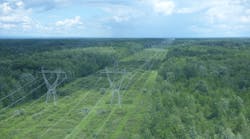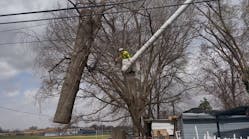Vegetation within electric transmission line corridors is maintained to ensure safe and adequate tree clearances to energized conductors. Tall growing trees are incompatible with the purpose of the right of way (ROW), and if left to grow unchecked, may encroach to within Minimum Vegetation Clearance Distance (MVCD) from energized lines. Fines for failing to maintain tree-conductor clearances can be significant (USD $1M/day).
The cost of maintaining the vegetation on transmission line ROW, however, is also significant and neverending; vegetation must be maintained forever. An important question for every manager is how often must it be done? Wait too long, and the cost of maintenance increases along with the risk of noncompliance. But performing preventive maintenance too frequently results in unnecessary expense with no added benefit.
This project focused on identifying factors to be considered in determining optimal preventive vegetation maintenance intervals. It helps the manager understand the costs associated with accelerating or deferring that work.
The project first identified the most common vegetation maintenance practices using an iterative Delphi process. It then adapted an economic model used in two previous studies to project the changes in the height and density of the vegetation in response to commonly used treatments and to estimate the impact these changes have on the cost of maintenance. That approach was applied in this project, which focuses on chemical and physical control methods as defined in Integrated Vegetation Management (IVM). The analysis permitted identification of the optimum frequency of treatment for herbicide applications and mechanical mastication of woody vegetation and assessment of the impact of accelerating or delaying treatment.
Current Practices
Common vegetation maintenance practices of electric utilities were first identified by subject matter experts from utilities throughout North America. This initial list of control methods was used to develop an industry survey sent to 174 investor-owned utilities. Twenty-seven utilities that manage nearly 160,000 miles of ROW responded.
Survey results demonstrate the range and prevalence of IVM control methods used to maintain vegetation on high-voltage transmission ROWs across the utility vegetation management industry. These results confirm the low volume foliar chemical control method as a dominant practice. The survey also confirms that physical control methods (mastication and hand cutting) that do not include application of herbicides have a significant role in IVM programs.
Determining the Cost of Treatments
The cost of applying the most common IVM-based control methods in the field is largely dependent on the vegetation conditions, predominantly, the height and density of the vegetation. Changes in the density and height of incompatible vegetation over time are dependent on the treatments used.
Earlier work on which this study was based used density and height models that are well-grounded in the literature. They clearly demonstrate a difference between chemical-based and physical control methods. Chemical and physical control methods reduce the number of incompatible plants occupying the site over time, but physical control methods have a much smaller impact on stem density and, even after many repetitive treatments, density remains substantially higher.
While stem density remains relatively constant between treatments, the height of incompatible stems does not. The height of vegetation increases with each growing season. Sites managed with physical control methods such as mastication tend to have a faster re-growth response rate than those managed using herbicides. This is because incompatible plants on sites treated by herbicides tend to be new seedlings demonstrating natural height growth. Plants on physically controlled sites are predominantly sprouts from cut stems with developed root systems and demonstrate an exaggerated height re-growth response.
The height and density of incompatible vegetation are a major considerations in deciding how and when to maintain a site and two primary factors influencing the cost of maintenance. The researchers used stocking tables combining density and height to establish the cost for each commonly used method. These cost estimates were refined with input from knowledgeable SMEs and revised to reflect current market rates.
It is important to note that the cost estimates used are generalized averages for each IVM control method across a range of height and density classes. Actual costs can vary significantly due to factors such as differences in the cost of labor and materials, site difficulty, season, as well as density of the compatible plant community.
Analysis and Findings
This project made a distinction between direct and indirect cost of deferral. The relative cost of various control methods over the time interval of interest is presented in Table 1. The values reported are the present value of direct costs of vegetation maintenance over a 20-year period (PVC20 yr.). When only the direct cost of preventive vegetation on electric transmission ROWs is considered, the lowest PVC20 yr. within the timeframe being evaluated represents the economically optimum interval.
For the physical control method, the economic optimum (lowest cost) is six years. This is due to the relative inelasticity of the cost of mastication across a wide range of stocking. In contrast, the optimal interval for the low volume foliar application, the dominant chemical control method, is four years. Four years could also be a reasonable choice for the other two chemical control methods, as the PVC20 yr. for each are within the range of uncertainty for this investigation. This four-year IVM interval reflects current industry practice.
An industry survey of 22 transmission vegetation management programs reported an average interval for chemical control work of 3.9 years and ranged between two and six years. That same survey reported an average interval for physical control of 3.9 years, with a wider range of one to eight years.
The economically optimal preventive maintenance interval can be used to answer the question of the cost of deferral. This is simply the cost premium of waiting too long. This same logic can also be used to estimate the cost of performing preventive maintenance on too short an interval. The results of this analysis are presented in Table 2.
The relatively small differences in costs in later years of the assessment interval should also be recognized and understood in the context of uncertainty in this analysis. Practically speaking, there is little difference in year 5 and 6 PVC20 yr.
Risk of Deferral
While conceptually, the vegetation manager may be able to extend maintenance beyond the economically optimal interval, practicality limits how long it can be deferred. Deferring maintenance is accompanied by an increasing risk of non-compliance. This can be considered an indirect cost.
Analysis of the indirect cost used the IVM principles of Tolerances Level (TL) and Action Threshold (AT). The TL defines a level of incompatible plant pressure that cannot be exceeded, and the AT defines when maintenance should occur to avoid exceeding the TL. In this investigation the TL was based on Minimum Vegetation Clearances Distances (MVCD) found in NERC FAC-003.4. A company cannot defer maintenance to the point where trees are out of compliance.
When the risk of noncompliance with mandatory MVCDs applicable to the North American high-voltage grid is considered, the sole determinant of an optimum cycle can be the height of incompatible trees before there is risk of an MVCD violation. This is illustrated in Table 3 and Table 4. Vegetation maintenance must occur before incompatible vegetation has the potential to reach the TL, which in this case is defined as the maximum allowable height. Potential fines associated with findings of MVCD non-compliance are orders of magnitude greater than direct costs. The growing season prior to this point would then be the longest interval since prior maintenance in which an IVM treatment should occur and becomes the action threshold.
It is important to recognize that a cost-efficient strategy to mitigating the risk of an MVCD violation can include judicious use of the hand cut and treat chemical control method. This would focus on controlling those stems that exhibit the most exaggerated regrowth response, potentially allowing a longer interval between comprehensive preventive maintenance.
The objective of this project was to provide vegetation managers with an understanding of factors that impact the cost of vegetation maintenance work. This study clearly demonstrates the importance of understanding the optimum maintenance interval for the specific ROW conditions. A shortened interval always costs more. A longer interval often costs more and always increases risk.
Editor’s Note: This project was funded by the Electric Power research Institute (EPRI). The authors are grateful for the support of Ashley Bennett, EPRI Project Manager in authorizing our sharing this information with the industry.
John Goodfellow ([email protected]) has more than 40 years of experience in the utility industry, having held positions of increasing responsibility for Utility Vegetation Management (UVM), Transmission & Distributions (T&D) operations, maintenance, engineering, and construction at three large investor-owned electric & gas utilities. He currently is Principal Consultant with Compliance Consulting, Inc and has been a regular contributor to T&D World Magazines on matters related to utility vegetation management.
Philip M. Charlton, Ph.D. ([email protected]) has 40 years of experience in the electric utility vegetation management industry. He retired as President and COO of ECI after 26 years during which he led in developing vegetation management programs for 150 electric utilities worldwide. He is now the principal of Charlton & Associates, serves as the Executive Director of the UAA with 6,000 professionals engaged in utility vegetation management, and is a Lead Auditor for the Rights-of-Way Stewardship Council.













